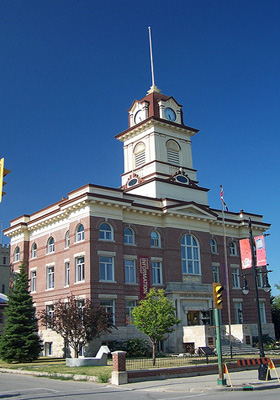St. Boniface City Hall National Historic Site of Canada
St. Boniface, Manitoba

General view
© St. Boniface City Hall, Lil Zebra, 2005.
Address :
219 Provencher Boulevard, St. Boniface, Manitoba
Recognition Statute:
Historic Sites and Monuments Act (R.S.C., 1985, c. H-4)
Designation Date:
1984-11-23
Dates:
-
1905 to 1905
(Construction)
-
1911 to 1911
(Significant)
Event, Person, Organization:
-
City of St.Boniface
(Organization)
-
Victor Horwood
(Architect)
Other Name(s):
-
St. Boniface City Hall
(Designation Name)
-
St. Boniface Community Development and Recreation Services Office
(Other Name)
Research Report Number:
Town Hall Study - 1984
Plaque(s)
Existing plaque: 219 Provencher Boulevard, on the second floor, Manitoba
This city hall was built in 1905 during a period of rapid growth in St. Boniface. The imposing classically-detailed building designed by Victor W. Horwood provided accommodations for the increasing number of services administered by the civic government. It serves as an enduring landmark and symbol of pride for this thriving community. One of a succession of large municipal buildings that appeared in Canadian towns and cities after 1900 in response to the growth of local government, it is an outstanding example of this building type in Western Canada.
Description of Historic Place
Situated at a prominent intersection in St.Boniface, the French-speaking mission that became an urban district of metropolitan Winnipeg, the St.Boniface City Hall is a classically styled, three- storey, red brick structure with central domed tower, built in the early twentieth century. The formal recognition is confined to the civic building itself.
Heritage Value
The St.Boniface City Hall was designated a national historic site in 1984 because: it provided accommodation for the increasing number of services administered by the St.Boniface civic government; and because this imposing classically detailed city hall is an outstanding example of its building type in Western Canada.
Constructed by the William Grace Company of Winnipeg in 1905, the new city hall was carefully planned to identify St.Boniface as separate from its neighbouring municipalities in attracting population and investment. The large size and formal Classical-revival style was thought to convey the dominance, stability and optimism as a visual symbol of the small city. Yielding to public pressure after its construction, the architect replaced its original tower with the existing one in 1911. An addition was made to the rear of the building when it underwent restoration in 1988, at which time clocks were installed in the tower. When St. Boniface ceased to be a separate city on amalgamation with Winnipeg in 1972, this city hall was adapted as space for the centralized civic administration.
Source: Historic Sites and Monuments Board of Canada, minute, November 1986.
Character-Defining Elements
Aspects of this site which contribute to its heritage values include: Its prominent siting on the main street of the community of old St. Boniface, set back from the street on a large treed lot within the civic precinct; Its monumental massing and rectangular footprint as of 1984; Its red brick exterior facing materials contrasted with rusticated masonry basement and buff limestone trim; Its Classical-revival style with formally symmetrical façade comprised of projecting pedimented central and end pavilions, heavy dentilled cornice, regularly spaced windows, the first two stories of transomed windows with limestone heads and sills, the third floor of smaller round-headed windows with stylized keystones; its emphasis on the central entry with original double doors within a limestone portico with flanking columns and imposing limestone stairway, double-height round-headed window above, surmounted by a square domed lantern; original interior features and materials and layout, particular in the major public spaces such as the former Council Chambers, the double-return staircase, interior columns, stained British Columbia fir woodwork and pressed tin ceilings.